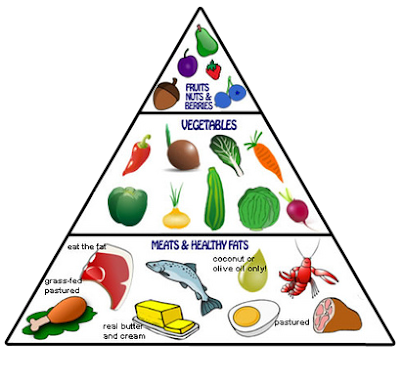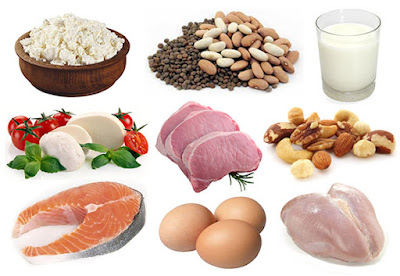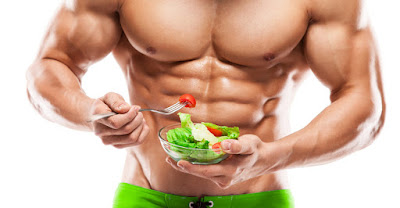THE MEN’S FITNESS FOOD PYRAMID
The Food Pyramid was so
misleading and inaccurate that in 2011 it was replaced with the USDA’s MyPlate,
an improved but still flawed approach to fighting obesity. To be fair, the
government’s nutrition advice is aimed at the average American who desires to
be in only average shape. As we assume
you picked up this book to be bigger, stronger, more ripped, and healthier than
that, you need an entirely different approach. To that end, we’ve created the
Men’s Fitness Food Pyramid—an easy visual guide to eating for physique enhancement,
performance, and optimal health. See how the pyramid works below and then use
it to build a better body.
HIT YOUR NUMBERS
As a physique-conscious
eater, you need to think in terms of macronutrients as well as calories. Every
food you eat gets counted toward a total target amount of protein, carbs, and fat,
which you can determine by multiplying the numbers in the Men’s Fitness Food Pyramid
by your body weight in pounds. Hit these numbers and you’ll hit your goals.
With that said, your
nutrition doesn’t need to be as precise as target coordinates for a missile
attack. You’ll do just fine eyeballing portions of protein, carbs, and fat and
keeping a general tally.
MAKE ADJUSTMENTS AS
NECESSARY
The calorie and macronutrient
recommendations here are just a starting point. Every trainee needs to find the
proper amounts for his own body. If you’re not losing weight, reduce your carbs
gradually, and try experimenting with bumping up your protein and fat intake a
bit. If you feel as if you can’t gain weight, you can add more carbs and even
more fat, which will increase your calories sharply. For any formulation you
make, give it at least a week to take effect before you make any changes.
With protein being the
main component of muscle tissue, your intake of it must remain high no matter
your goal. To make size gains, you need at least one gram of protein per pound
of your body weight to support optimal growth. When dieting, you must create a
caloric deficit—but that can cause muscle loss if you end up cutting protein to
do it. That’s why we increase protein intake and decrease starchy carbs. To get
lean, you may increase your protein to as many as 1.5 grams per pound of body
weight; but start lower and increase gradually as you reduce your calories
slowly. If you feel like you’re not recovering from training or you’re losing
muscle, up the protein fast. The best protein sources are eggs, chicken, fish,
lean beef, turkey, quinoa, and protein powder. A three-ounce portion of lean
meat or fish is about the size and thickness of the palm of your hand and
contains 20–25 grams of protein, five grams of fat or fewer, and zero carbs.
CARBS
All carbohydrates break
down into glucose, raising your
blood sugar levels
faster than any other nutrient. As a result, the pancreas releases insulin to
remove surplus sugar from the bloodstream and maintain normal levels. Research,
including a study at the University of Washington School of Medicine, has found
that exercise— particularly strength training—increases insulin sensitivity in
the muscles. So if you’ve just worked out, more of the carbs you eat afterward
will be carried by insulin directly to your muscles for replenishment. On the
other hand, if you’ve been sitting on the couch watching football, those carbs
will just get stored around your waist.
For this reason, we recommend
that most of your carbs come before, during, and shortly after training. It
also means that you need to eat fewer carbs when you want to get lean—you need
to keep insulin levels low. “If someone is in fat-loss mode,” says John
Meadows, C.S.S.N., a nutrition coach and national-level bodybuilder, “I like to
limit carbs to pre-, intra-, and post-workout meals, when they’ll go where you
want them”—that is, to muscle tissue. For muscle gain, Meadows prefers to add
carbs to meals around training time first, before adding them to other meals.
Carb foods include
potatoes, sweet potatoes, rice, oats, fruits, and vegetables. Fruits should be
consumed in their whole-food form and limited to two or three pieces daily .
Green vegetables can be eaten steadily regardless of the goal. Eat one gram of
carbohydrate per pound of your body weight when dieting and two grams per pound
when you want to put on muscle.
A fist-size portion of
cooked rice or potatoes is about one cup and gives you 40–45 grams of carbs and
negligible protein and fat.
FAT
“We need to provide a baseline
level of good fats for hormone production,” says Nate Miyaki, C.S.S.N., a nutrition
consultant and bodybuilder in San Francisco, CA. Fat, particularly the
much-maligned saturated kind, helps in the creation of testosterone, which does
everything from getting you big and lean to keeping your “little friend” ready
to say hello. Contrary to popular opinion, when dieting, you don’t need to drop
your fat intake much, if at all; fat loss comes fastest when carbohydrate
intake is reduced. Plus, fat is satiating as well as a good source of energy.
Most of your fats should
come by way of your protein foods, but avocados, nuts, seeds, and a small
amount of oil like coconut and olive oil can be included as well. Aim for 0.4
grams per pound of your body weight daily to start. One tablespoon of any oil
is about 15 grams of fat, and one cup of almonds or peanuts has 70 grams of
fat. Two tablespoons of nut butter is about the length of your thumb and
contains 15–20 grams of fat.
Research hasn’t yet
clarified the optimal amount of protein or carbs you should eat around workouts
for the maximum benefit. But it is clear that some is better than none, and the
presence of both is crucial. A 2006 study in the European Journal of Applied
Physiology gave male subjects one of the following to consume after weight training:
a 6 percent carbohydrate solution, six grams of amino acids, a combination
of both, or a placebo. Those drinking
the carb-and-aminos shake experienced greater muscle gains than any of the other
groups, which the researchers presumed was because the concoction did the most
to reduce muscle protein breakdown after training.
Meadows recommends
taking in 25–50 grams of protein, 25–35 grams of carbs, and 10 grams of fat
before training. Afterward, consume another 20–40 grams of protein and 40–80
grams of carbs—you can begin chugging this shake during the workout as well to
limit muscle breakdown even further, though this may not be necessary and could
upset your stomach. We like to make shakes with whey isolate or hydrolysate as
the protein source, and Vitargo or highly branched cyclic dextrin for carbs.
If powders and shakes
aren’t in your budget, Miyaki says you can go old-school and eat fruit pre- and
post-workout. One or two pieces should provide enough carbs to halt muscle
breakdown. And a lean three-ounce slice of protein to accompany it is fine.








